Clinical Reasoning Case Study: Bryan A - Hospital Admission and Care
VerifiedAdded on 2022/08/26
|11
|4428
|11
Case Study
AI Summary
This case study focuses on Bryan A, a 26-year-old male admitted to the hospital after a near-drowning incident at Bondi Beach. The assignment follows a clinical reasoning framework, beginning with an observation of the patient's condition, including his initial presentation (moaning, no visible injuries, wet clothing), and the context of the situation. It involves gathering and reviewing data, including vital signs (pulseless VT, ROSC), ABG report, and medical history. The subsequent steps involve processing information to interpret signs and symptoms, such as a rapid heart rate, crackles in the lungs, and respiratory acidosis, and also distinguishing relevant from irrelevant information. The study identifies relationships in the clinical data, predicts potential outcomes if left untreated (pneumonia, pneumothorax), and matches the patient's situation to existing literature. It then synthesizes this information to formulate a nursing diagnosis, establishes immediate goals using the A-G approach (airway, breathing, circulation, etc.), and outlines the actions a nurse would take in response, including airway assessment, breathing support, and circulation monitoring. The evaluation of interventions and reflection on the learning process are also included, providing a comprehensive analysis of the case.
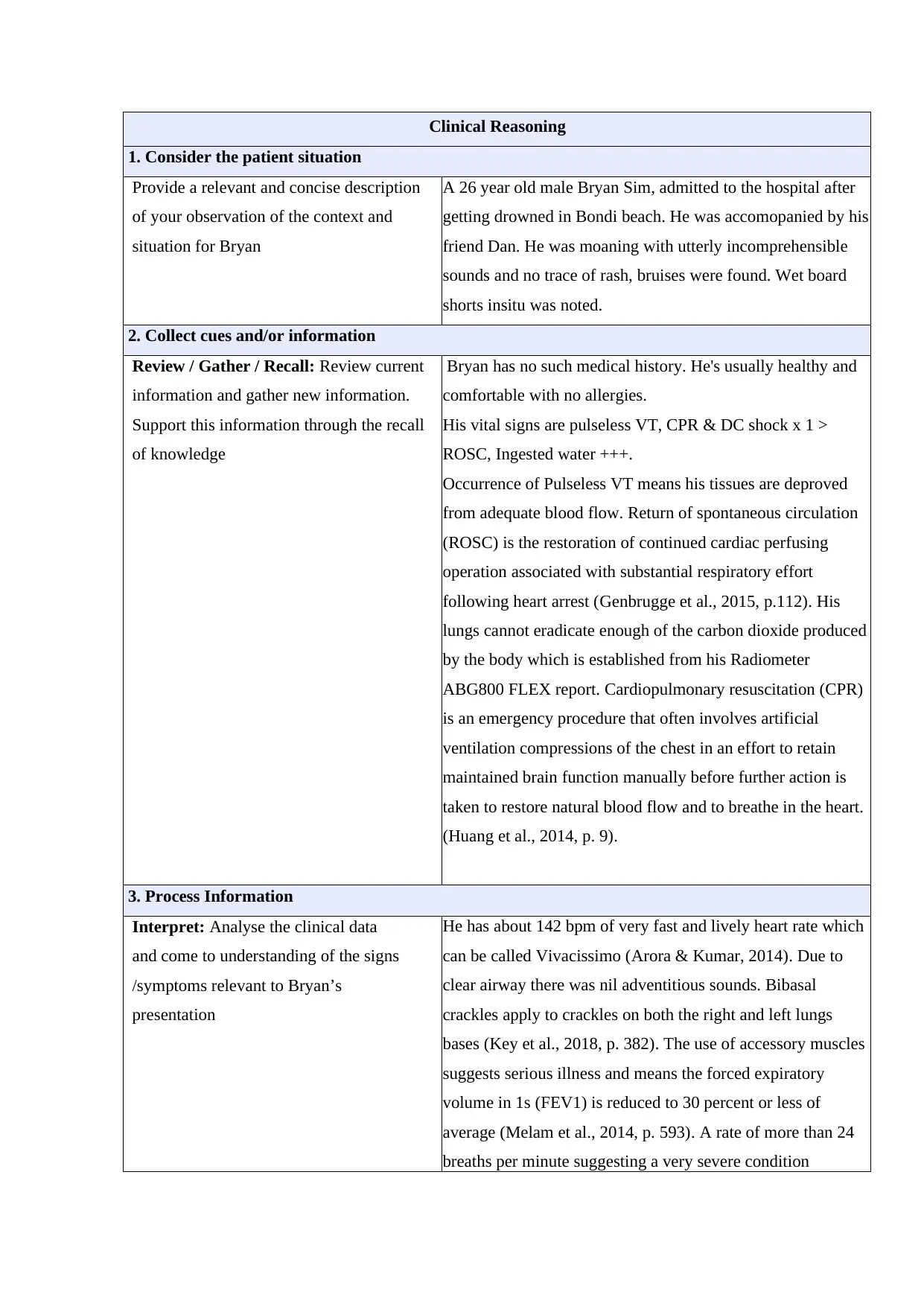
Clinical Reasoning
1. Consider the patient situation
Provide a relevant and concise description
of your observation of the context and
situation for Bryan
A 26 year old male Bryan Sim, admitted to the hospital after
getting drowned in Bondi beach. He was accomopanied by his
friend Dan. He was moaning with utterly incomprehensible
sounds and no trace of rash, bruises were found. Wet board
shorts insitu was noted.
2. Collect cues and/or information
Review / Gather / Recall: Review current
information and gather new information.
Support this information through the recall
of knowledge
Bryan has no such medical history. He's usually healthy and
comfortable with no allergies.
His vital signs are pulseless VT, CPR & DC shock x 1 >
ROSC, Ingested water +++.
Occurrence of Pulseless VT means his tissues are deproved
from adequate blood flow. Return of spontaneous circulation
(ROSC) is the restoration of continued cardiac perfusing
operation associated with substantial respiratory effort
following heart arrest (Genbrugge et al., 2015, p.112). His
lungs cannot eradicate enough of the carbon dioxide produced
by the body which is established from his Radiometer
ABG800 FLEX report. Cardiopulmonary resuscitation (CPR)
is an emergency procedure that often involves artificial
ventilation compressions of the chest in an effort to retain
maintained brain function manually before further action is
taken to restore natural blood flow and to breathe in the heart.
(Huang et al., 2014, p. 9).
3. Process Information
Interpret: Analyse the clinical data
and come to understanding of the signs
/symptoms relevant to Bryan’s
presentation
He has about 142 bpm of very fast and lively heart rate which
can be called Vivacissimo (Arora & Kumar, 2014). Due to
clear airway there was nil adventitious sounds. Bibasal
crackles apply to crackles on both the right and left lungs
bases (Key et al., 2018, p. 382). The use of accessory muscles
suggests serious illness and means the forced expiratory
volume in 1s (FEV1) is reduced to 30 percent or less of
average (Melam et al., 2014, p. 593). A rate of more than 24
breaths per minute suggesting a very severe condition
1. Consider the patient situation
Provide a relevant and concise description
of your observation of the context and
situation for Bryan
A 26 year old male Bryan Sim, admitted to the hospital after
getting drowned in Bondi beach. He was accomopanied by his
friend Dan. He was moaning with utterly incomprehensible
sounds and no trace of rash, bruises were found. Wet board
shorts insitu was noted.
2. Collect cues and/or information
Review / Gather / Recall: Review current
information and gather new information.
Support this information through the recall
of knowledge
Bryan has no such medical history. He's usually healthy and
comfortable with no allergies.
His vital signs are pulseless VT, CPR & DC shock x 1 >
ROSC, Ingested water +++.
Occurrence of Pulseless VT means his tissues are deproved
from adequate blood flow. Return of spontaneous circulation
(ROSC) is the restoration of continued cardiac perfusing
operation associated with substantial respiratory effort
following heart arrest (Genbrugge et al., 2015, p.112). His
lungs cannot eradicate enough of the carbon dioxide produced
by the body which is established from his Radiometer
ABG800 FLEX report. Cardiopulmonary resuscitation (CPR)
is an emergency procedure that often involves artificial
ventilation compressions of the chest in an effort to retain
maintained brain function manually before further action is
taken to restore natural blood flow and to breathe in the heart.
(Huang et al., 2014, p. 9).
3. Process Information
Interpret: Analyse the clinical data
and come to understanding of the signs
/symptoms relevant to Bryan’s
presentation
He has about 142 bpm of very fast and lively heart rate which
can be called Vivacissimo (Arora & Kumar, 2014). Due to
clear airway there was nil adventitious sounds. Bibasal
crackles apply to crackles on both the right and left lungs
bases (Key et al., 2018, p. 382). The use of accessory muscles
suggests serious illness and means the forced expiratory
volume in 1s (FEV1) is reduced to 30 percent or less of
average (Melam et al., 2014, p. 593). A rate of more than 24
breaths per minute suggesting a very severe condition
Paraphrase This Document
Need a fresh take? Get an instant paraphrase of this document with our AI Paraphraser
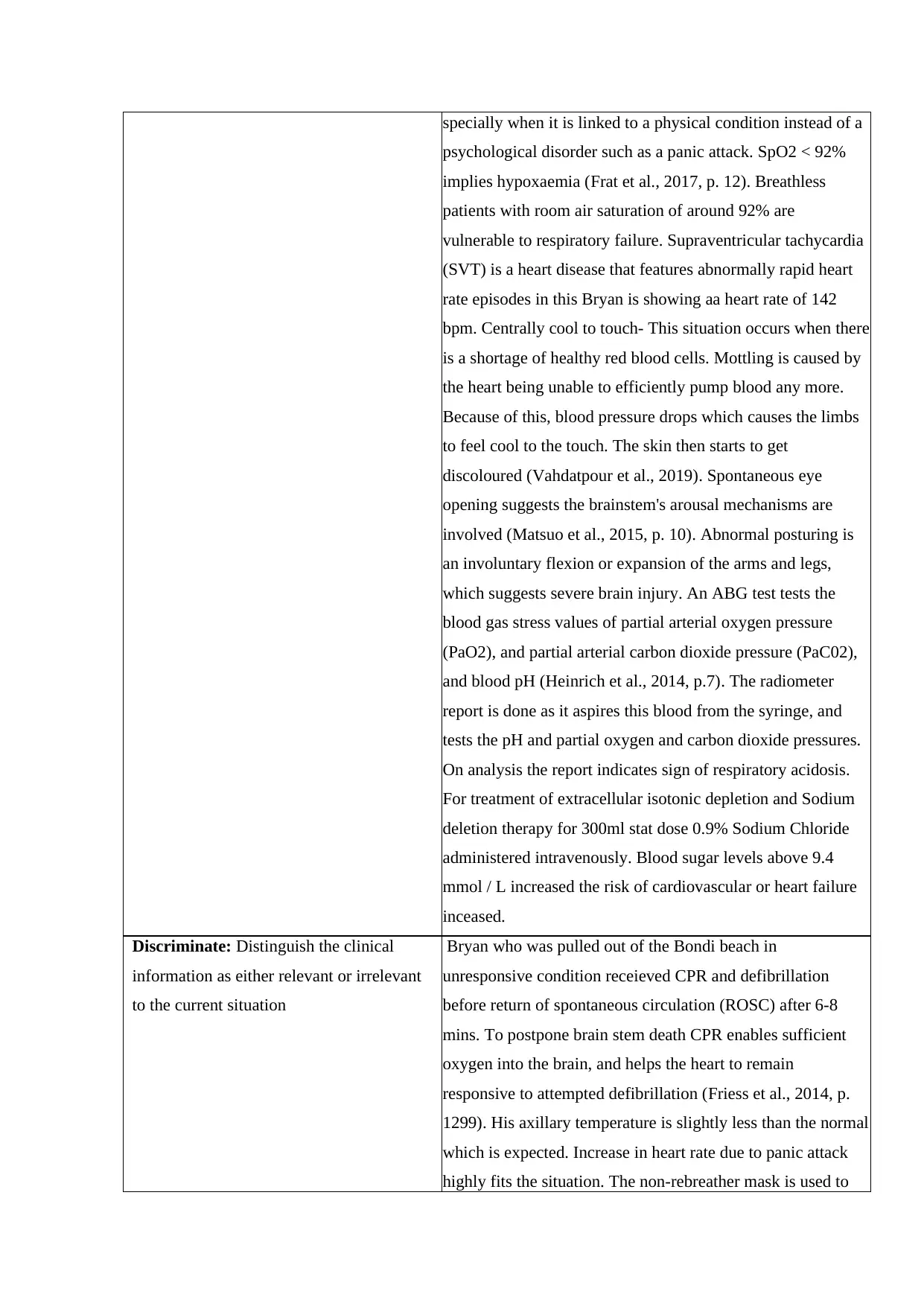
specially when it is linked to a physical condition instead of a
psychological disorder such as a panic attack. SpO2 < 92%
implies hypoxaemia (Frat et al., 2017, p. 12). Breathless
patients with room air saturation of around 92% are
vulnerable to respiratory failure. Supraventricular tachycardia
(SVT) is a heart disease that features abnormally rapid heart
rate episodes in this Bryan is showing aa heart rate of 142
bpm. Centrally cool to touch- This situation occurs when there
is a shortage of healthy red blood cells. Mottling is caused by
the heart being unable to efficiently pump blood any more.
Because of this, blood pressure drops which causes the limbs
to feel cool to the touch. The skin then starts to get
discoloured (Vahdatpour et al., 2019). Spontaneous eye
opening suggests the brainstem's arousal mechanisms are
involved (Matsuo et al., 2015, p. 10). Abnormal posturing is
an involuntary flexion or expansion of the arms and legs,
which suggests severe brain injury. An ABG test tests the
blood gas stress values of partial arterial oxygen pressure
(PaO2), and partial arterial carbon dioxide pressure (PaC02),
and blood pH (Heinrich et al., 2014, p.7). The radiometer
report is done as it aspires this blood from the syringe, and
tests the pH and partial oxygen and carbon dioxide pressures.
On analysis the report indicates sign of respiratory acidosis.
For treatment of extracellular isotonic depletion and Sodium
deletion therapy for 300ml stat dose 0.9% Sodium Chloride
administered intravenously. Blood sugar levels above 9.4
mmol / L increased the risk of cardiovascular or heart failure
inceased.
Discriminate: Distinguish the clinical
information as either relevant or irrelevant
to the current situation
Bryan who was pulled out of the Bondi beach in
unresponsive condition receieved CPR and defibrillation
before return of spontaneous circulation (ROSC) after 6-8
mins. To postpone brain stem death CPR enables sufficient
oxygen into the brain, and helps the heart to remain
responsive to attempted defibrillation (Friess et al., 2014, p.
1299). His axillary temperature is slightly less than the normal
which is expected. Increase in heart rate due to panic attack
highly fits the situation. The non-rebreather mask is used to
psychological disorder such as a panic attack. SpO2 < 92%
implies hypoxaemia (Frat et al., 2017, p. 12). Breathless
patients with room air saturation of around 92% are
vulnerable to respiratory failure. Supraventricular tachycardia
(SVT) is a heart disease that features abnormally rapid heart
rate episodes in this Bryan is showing aa heart rate of 142
bpm. Centrally cool to touch- This situation occurs when there
is a shortage of healthy red blood cells. Mottling is caused by
the heart being unable to efficiently pump blood any more.
Because of this, blood pressure drops which causes the limbs
to feel cool to the touch. The skin then starts to get
discoloured (Vahdatpour et al., 2019). Spontaneous eye
opening suggests the brainstem's arousal mechanisms are
involved (Matsuo et al., 2015, p. 10). Abnormal posturing is
an involuntary flexion or expansion of the arms and legs,
which suggests severe brain injury. An ABG test tests the
blood gas stress values of partial arterial oxygen pressure
(PaO2), and partial arterial carbon dioxide pressure (PaC02),
and blood pH (Heinrich et al., 2014, p.7). The radiometer
report is done as it aspires this blood from the syringe, and
tests the pH and partial oxygen and carbon dioxide pressures.
On analysis the report indicates sign of respiratory acidosis.
For treatment of extracellular isotonic depletion and Sodium
deletion therapy for 300ml stat dose 0.9% Sodium Chloride
administered intravenously. Blood sugar levels above 9.4
mmol / L increased the risk of cardiovascular or heart failure
inceased.
Discriminate: Distinguish the clinical
information as either relevant or irrelevant
to the current situation
Bryan who was pulled out of the Bondi beach in
unresponsive condition receieved CPR and defibrillation
before return of spontaneous circulation (ROSC) after 6-8
mins. To postpone brain stem death CPR enables sufficient
oxygen into the brain, and helps the heart to remain
responsive to attempted defibrillation (Friess et al., 2014, p.
1299). His axillary temperature is slightly less than the normal
which is expected. Increase in heart rate due to panic attack
highly fits the situation. The non-rebreather mask is used to
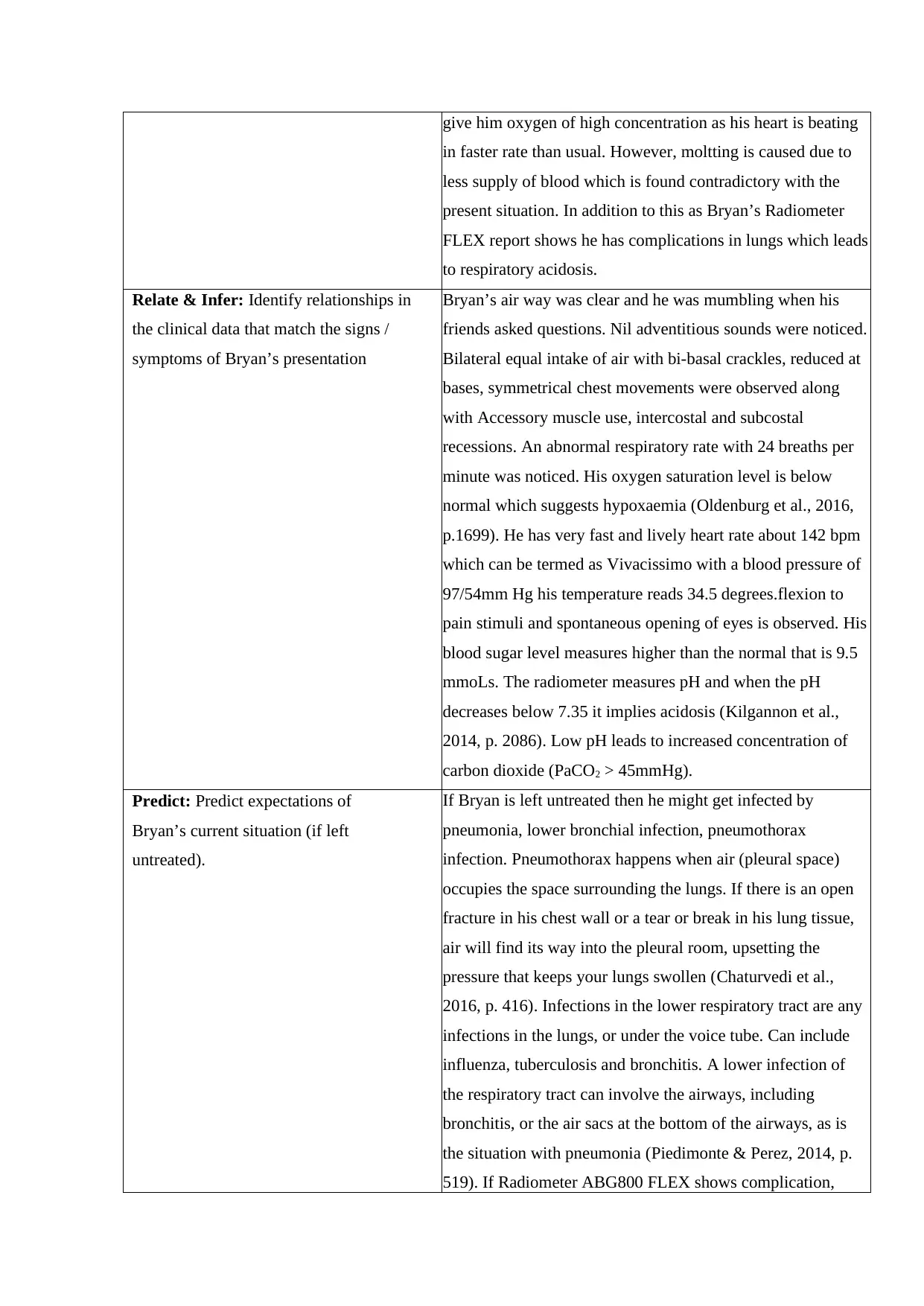
give him oxygen of high concentration as his heart is beating
in faster rate than usual. However, moltting is caused due to
less supply of blood which is found contradictory with the
present situation. In addition to this as Bryan’s Radiometer
FLEX report shows he has complications in lungs which leads
to respiratory acidosis.
Relate & Infer: Identify relationships in
the clinical data that match the signs /
symptoms of Bryan’s presentation
Bryan’s air way was clear and he was mumbling when his
friends asked questions. Nil adventitious sounds were noticed.
Bilateral equal intake of air with bi-basal crackles, reduced at
bases, symmetrical chest movements were observed along
with Accessory muscle use, intercostal and subcostal
recessions. An abnormal respiratory rate with 24 breaths per
minute was noticed. His oxygen saturation level is below
normal which suggests hypoxaemia (Oldenburg et al., 2016,
p.1699). He has very fast and lively heart rate about 142 bpm
which can be termed as Vivacissimo with a blood pressure of
97/54mm Hg his temperature reads 34.5 degrees.flexion to
pain stimuli and spontaneous opening of eyes is observed. His
blood sugar level measures higher than the normal that is 9.5
mmoLs. The radiometer measures pH and when the pH
decreases below 7.35 it implies acidosis (Kilgannon et al.,
2014, p. 2086). Low pH leads to increased concentration of
carbon dioxide (PaCO2 > 45mmHg).
Predict: Predict expectations of
Bryan’s current situation (if left
untreated).
If Bryan is left untreated then he might get infected by
pneumonia, lower bronchial infection, pneumothorax
infection. Pneumothorax happens when air (pleural space)
occupies the space surrounding the lungs. If there is an open
fracture in his chest wall or a tear or break in his lung tissue,
air will find its way into the pleural room, upsetting the
pressure that keeps your lungs swollen (Chaturvedi et al.,
2016, p. 416). Infections in the lower respiratory tract are any
infections in the lungs, or under the voice tube. Can include
influenza, tuberculosis and bronchitis. A lower infection of
the respiratory tract can involve the airways, including
bronchitis, or the air sacs at the bottom of the airways, as is
the situation with pneumonia (Piedimonte & Perez, 2014, p.
519). If Radiometer ABG800 FLEX shows complication,
in faster rate than usual. However, moltting is caused due to
less supply of blood which is found contradictory with the
present situation. In addition to this as Bryan’s Radiometer
FLEX report shows he has complications in lungs which leads
to respiratory acidosis.
Relate & Infer: Identify relationships in
the clinical data that match the signs /
symptoms of Bryan’s presentation
Bryan’s air way was clear and he was mumbling when his
friends asked questions. Nil adventitious sounds were noticed.
Bilateral equal intake of air with bi-basal crackles, reduced at
bases, symmetrical chest movements were observed along
with Accessory muscle use, intercostal and subcostal
recessions. An abnormal respiratory rate with 24 breaths per
minute was noticed. His oxygen saturation level is below
normal which suggests hypoxaemia (Oldenburg et al., 2016,
p.1699). He has very fast and lively heart rate about 142 bpm
which can be termed as Vivacissimo with a blood pressure of
97/54mm Hg his temperature reads 34.5 degrees.flexion to
pain stimuli and spontaneous opening of eyes is observed. His
blood sugar level measures higher than the normal that is 9.5
mmoLs. The radiometer measures pH and when the pH
decreases below 7.35 it implies acidosis (Kilgannon et al.,
2014, p. 2086). Low pH leads to increased concentration of
carbon dioxide (PaCO2 > 45mmHg).
Predict: Predict expectations of
Bryan’s current situation (if left
untreated).
If Bryan is left untreated then he might get infected by
pneumonia, lower bronchial infection, pneumothorax
infection. Pneumothorax happens when air (pleural space)
occupies the space surrounding the lungs. If there is an open
fracture in his chest wall or a tear or break in his lung tissue,
air will find its way into the pleural room, upsetting the
pressure that keeps your lungs swollen (Chaturvedi et al.,
2016, p. 416). Infections in the lower respiratory tract are any
infections in the lungs, or under the voice tube. Can include
influenza, tuberculosis and bronchitis. A lower infection of
the respiratory tract can involve the airways, including
bronchitis, or the air sacs at the bottom of the airways, as is
the situation with pneumonia (Piedimonte & Perez, 2014, p.
519). If Radiometer ABG800 FLEX shows complication,
⊘ This is a preview!⊘
Do you want full access?
Subscribe today to unlock all pages.

Trusted by 1+ million students worldwide
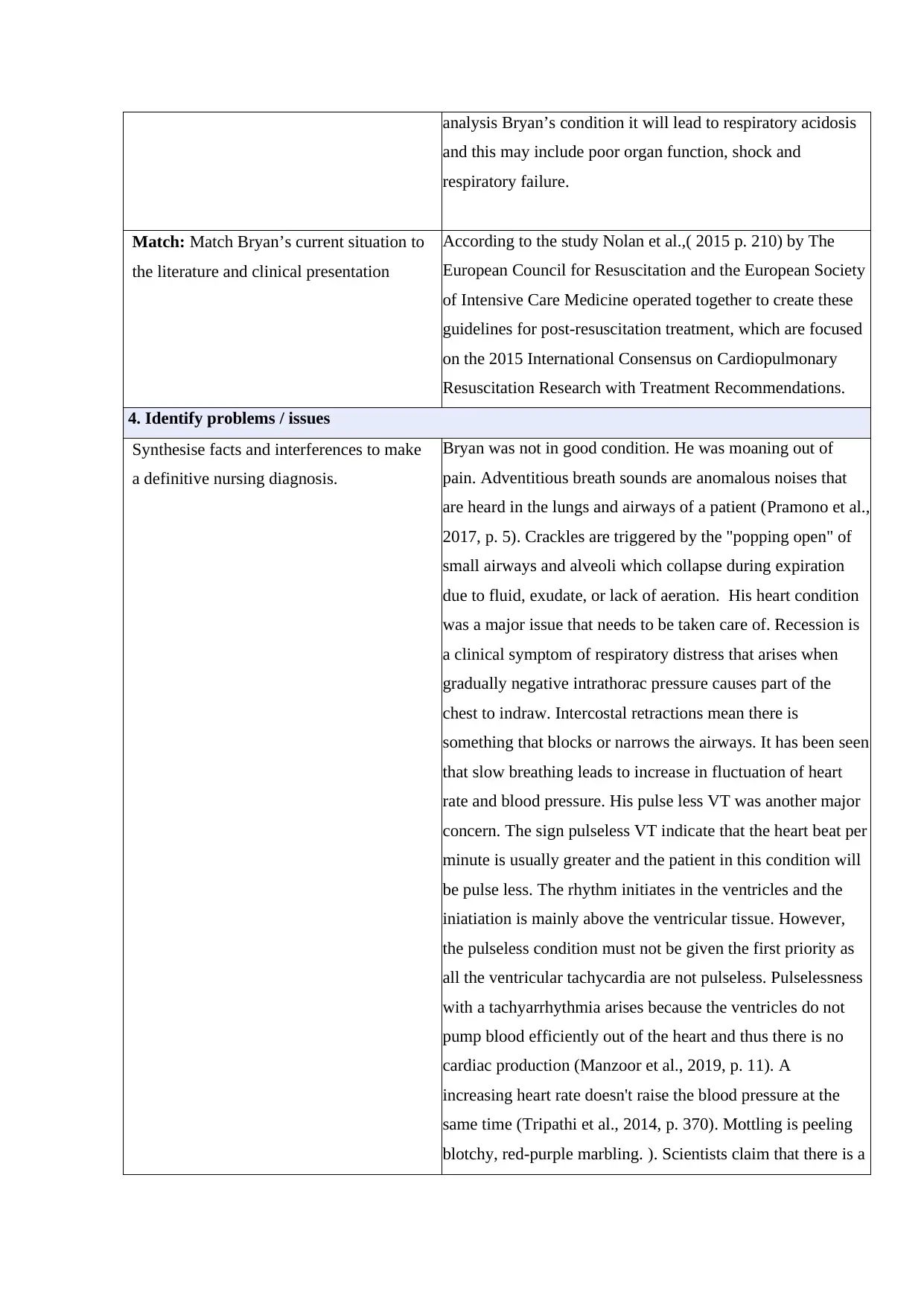
analysis Bryan’s condition it will lead to respiratory acidosis
and this may include poor organ function, shock and
respiratory failure.
Match: Match Bryan’s current situation to
the literature and clinical presentation
According to the study Nolan et al.,( 2015 p. 210) by The
European Council for Resuscitation and the European Society
of Intensive Care Medicine operated together to create these
guidelines for post-resuscitation treatment, which are focused
on the 2015 International Consensus on Cardiopulmonary
Resuscitation Research with Treatment Recommendations.
4. Identify problems / issues
Synthesise facts and interferences to make
a definitive nursing diagnosis.
Bryan was not in good condition. He was moaning out of
pain. Adventitious breath sounds are anomalous noises that
are heard in the lungs and airways of a patient (Pramono et al.,
2017, p. 5). Crackles are triggered by the "popping open" of
small airways and alveoli which collapse during expiration
due to fluid, exudate, or lack of aeration. His heart condition
was a major issue that needs to be taken care of. Recession is
a clinical symptom of respiratory distress that arises when
gradually negative intrathorac pressure causes part of the
chest to indraw. Intercostal retractions mean there is
something that blocks or narrows the airways. It has been seen
that slow breathing leads to increase in fluctuation of heart
rate and blood pressure. His pulse less VT was another major
concern. The sign pulseless VT indicate that the heart beat per
minute is usually greater and the patient in this condition will
be pulse less. The rhythm initiates in the ventricles and the
iniatiation is mainly above the ventricular tissue. However,
the pulseless condition must not be given the first priority as
all the ventricular tachycardia are not pulseless. Pulselessness
with a tachyarrhythmia arises because the ventricles do not
pump blood efficiently out of the heart and thus there is no
cardiac production (Manzoor et al., 2019, p. 11). A
increasing heart rate doesn't raise the blood pressure at the
same time (Tripathi et al., 2014, p. 370). Mottling is peeling
blotchy, red-purple marbling. ). Scientists claim that there is a
and this may include poor organ function, shock and
respiratory failure.
Match: Match Bryan’s current situation to
the literature and clinical presentation
According to the study Nolan et al.,( 2015 p. 210) by The
European Council for Resuscitation and the European Society
of Intensive Care Medicine operated together to create these
guidelines for post-resuscitation treatment, which are focused
on the 2015 International Consensus on Cardiopulmonary
Resuscitation Research with Treatment Recommendations.
4. Identify problems / issues
Synthesise facts and interferences to make
a definitive nursing diagnosis.
Bryan was not in good condition. He was moaning out of
pain. Adventitious breath sounds are anomalous noises that
are heard in the lungs and airways of a patient (Pramono et al.,
2017, p. 5). Crackles are triggered by the "popping open" of
small airways and alveoli which collapse during expiration
due to fluid, exudate, or lack of aeration. His heart condition
was a major issue that needs to be taken care of. Recession is
a clinical symptom of respiratory distress that arises when
gradually negative intrathorac pressure causes part of the
chest to indraw. Intercostal retractions mean there is
something that blocks or narrows the airways. It has been seen
that slow breathing leads to increase in fluctuation of heart
rate and blood pressure. His pulse less VT was another major
concern. The sign pulseless VT indicate that the heart beat per
minute is usually greater and the patient in this condition will
be pulse less. The rhythm initiates in the ventricles and the
iniatiation is mainly above the ventricular tissue. However,
the pulseless condition must not be given the first priority as
all the ventricular tachycardia are not pulseless. Pulselessness
with a tachyarrhythmia arises because the ventricles do not
pump blood efficiently out of the heart and thus there is no
cardiac production (Manzoor et al., 2019, p. 11). A
increasing heart rate doesn't raise the blood pressure at the
same time (Tripathi et al., 2014, p. 370). Mottling is peeling
blotchy, red-purple marbling. ). Scientists claim that there is a
Paraphrase This Document
Need a fresh take? Get an instant paraphrase of this document with our AI Paraphraser
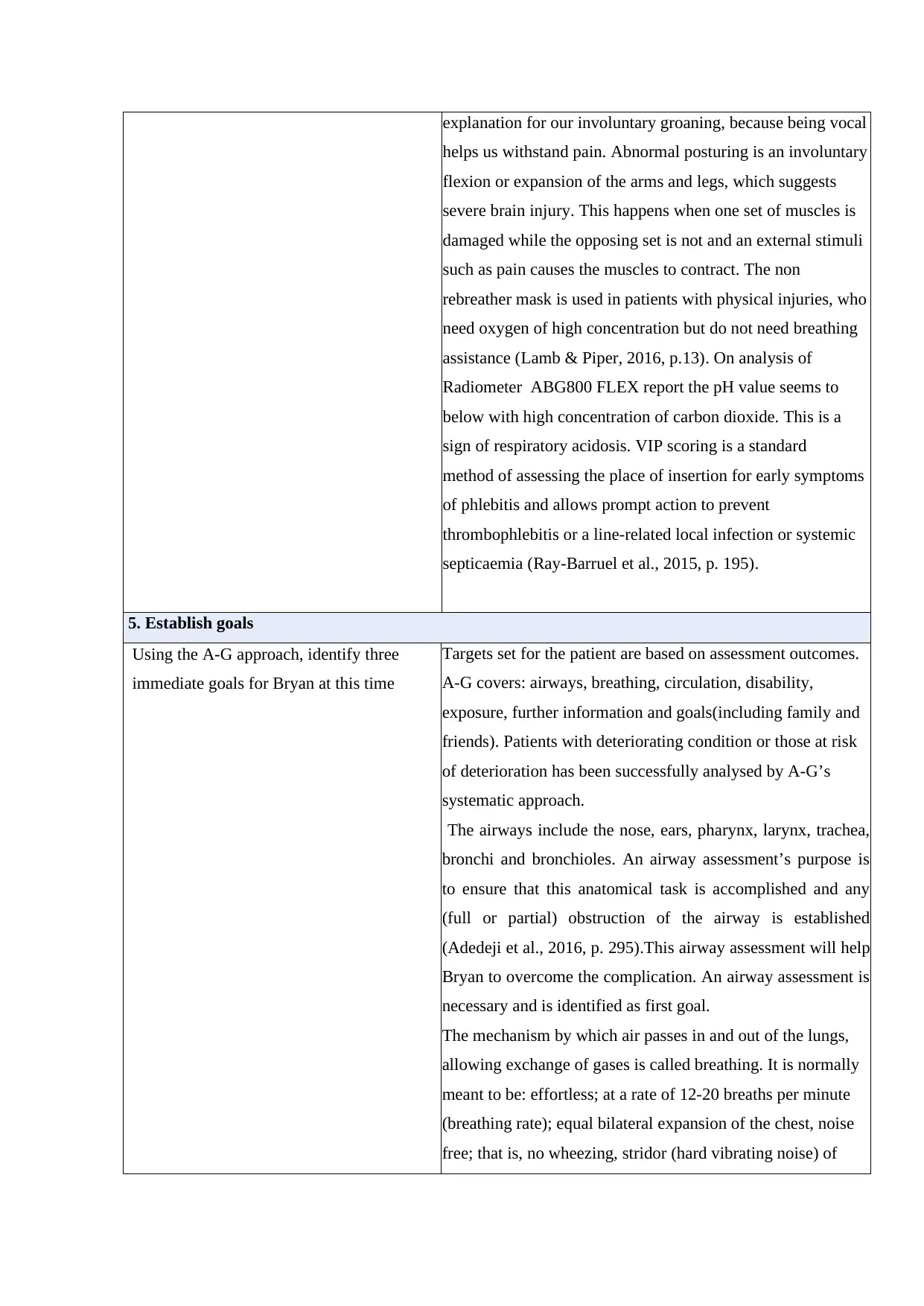
explanation for our involuntary groaning, because being vocal
helps us withstand pain. Abnormal posturing is an involuntary
flexion or expansion of the arms and legs, which suggests
severe brain injury. This happens when one set of muscles is
damaged while the opposing set is not and an external stimuli
such as pain causes the muscles to contract. The non
rebreather mask is used in patients with physical injuries, who
need oxygen of high concentration but do not need breathing
assistance (Lamb & Piper, 2016, p.13). On analysis of
Radiometer ABG800 FLEX report the pH value seems to
below with high concentration of carbon dioxide. This is a
sign of respiratory acidosis. VIP scoring is a standard
method of assessing the place of insertion for early symptoms
of phlebitis and allows prompt action to prevent
thrombophlebitis or a line-related local infection or systemic
septicaemia (Ray‐Barruel et al., 2015, p. 195).
5. Establish goals
Using the A-G approach, identify three
immediate goals for Bryan at this time
Targets set for the patient are based on assessment outcomes.
A-G covers: airways, breathing, circulation, disability,
exposure, further information and goals(including family and
friends). Patients with deteriorating condition or those at risk
of deterioration has been successfully analysed by A-G’s
systematic approach.
The airways include the nose, ears, pharynx, larynx, trachea,
bronchi and bronchioles. An airway assessment’s purpose is
to ensure that this anatomical task is accomplished and any
(full or partial) obstruction of the airway is established
(Adedeji et al., 2016, p. 295).This airway assessment will help
Bryan to overcome the complication. An airway assessment is
necessary and is identified as first goal.
The mechanism by which air passes in and out of the lungs,
allowing exchange of gases is called breathing. It is normally
meant to be: effortless; at a rate of 12-20 breaths per minute
(breathing rate); equal bilateral expansion of the chest, noise
free; that is, no wheezing, stridor (hard vibrating noise) of
helps us withstand pain. Abnormal posturing is an involuntary
flexion or expansion of the arms and legs, which suggests
severe brain injury. This happens when one set of muscles is
damaged while the opposing set is not and an external stimuli
such as pain causes the muscles to contract. The non
rebreather mask is used in patients with physical injuries, who
need oxygen of high concentration but do not need breathing
assistance (Lamb & Piper, 2016, p.13). On analysis of
Radiometer ABG800 FLEX report the pH value seems to
below with high concentration of carbon dioxide. This is a
sign of respiratory acidosis. VIP scoring is a standard
method of assessing the place of insertion for early symptoms
of phlebitis and allows prompt action to prevent
thrombophlebitis or a line-related local infection or systemic
septicaemia (Ray‐Barruel et al., 2015, p. 195).
5. Establish goals
Using the A-G approach, identify three
immediate goals for Bryan at this time
Targets set for the patient are based on assessment outcomes.
A-G covers: airways, breathing, circulation, disability,
exposure, further information and goals(including family and
friends). Patients with deteriorating condition or those at risk
of deterioration has been successfully analysed by A-G’s
systematic approach.
The airways include the nose, ears, pharynx, larynx, trachea,
bronchi and bronchioles. An airway assessment’s purpose is
to ensure that this anatomical task is accomplished and any
(full or partial) obstruction of the airway is established
(Adedeji et al., 2016, p. 295).This airway assessment will help
Bryan to overcome the complication. An airway assessment is
necessary and is identified as first goal.
The mechanism by which air passes in and out of the lungs,
allowing exchange of gases is called breathing. It is normally
meant to be: effortless; at a rate of 12-20 breaths per minute
(breathing rate); equal bilateral expansion of the chest, noise
free; that is, no wheezing, stridor (hard vibrating noise) of
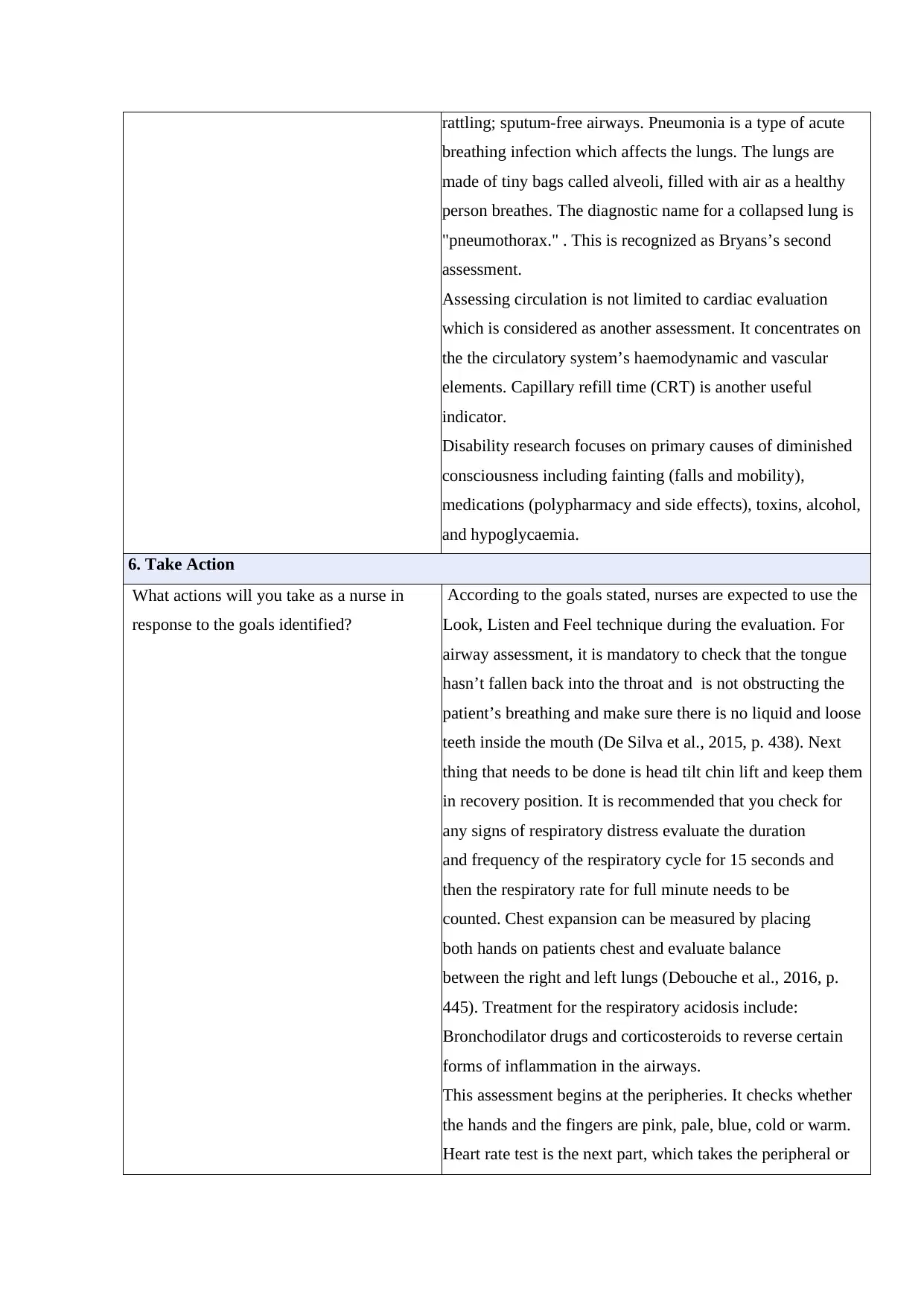
rattling; sputum-free airways. Pneumonia is a type of acute
breathing infection which affects the lungs. The lungs are
made of tiny bags called alveoli, filled with air as a healthy
person breathes. The diagnostic name for a collapsed lung is
"pneumothorax." . This is recognized as Bryans’s second
assessment.
Assessing circulation is not limited to cardiac evaluation
which is considered as another assessment. It concentrates on
the the circulatory system’s haemodynamic and vascular
elements. Capillary refill time (CRT) is another useful
indicator.
Disability research focuses on primary causes of diminished
consciousness including fainting (falls and mobility),
medications (polypharmacy and side effects), toxins, alcohol,
and hypoglycaemia.
6. Take Action
What actions will you take as a nurse in
response to the goals identified?
According to the goals stated, nurses are expected to use the
Look, Listen and Feel technique during the evaluation. For
airway assessment, it is mandatory to check that the tongue
hasn’t fallen back into the throat and is not obstructing the
patient’s breathing and make sure there is no liquid and loose
teeth inside the mouth (De Silva et al., 2015, p. 438). Next
thing that needs to be done is head tilt chin lift and keep them
in recovery position. It is recommended that you check for
any signs of respiratory distress evaluate the duration
and frequency of the respiratory cycle for 15 seconds and
then the respiratory rate for full minute needs to be
counted. Chest expansion can be measured by placing
both hands on patients chest and evaluate balance
between the right and left lungs (Debouche et al., 2016, p.
445). Treatment for the respiratory acidosis include:
Bronchodilator drugs and corticosteroids to reverse certain
forms of inflammation in the airways.
This assessment begins at the peripheries. It checks whether
the hands and the fingers are pink, pale, blue, cold or warm.
Heart rate test is the next part, which takes the peripheral or
breathing infection which affects the lungs. The lungs are
made of tiny bags called alveoli, filled with air as a healthy
person breathes. The diagnostic name for a collapsed lung is
"pneumothorax." . This is recognized as Bryans’s second
assessment.
Assessing circulation is not limited to cardiac evaluation
which is considered as another assessment. It concentrates on
the the circulatory system’s haemodynamic and vascular
elements. Capillary refill time (CRT) is another useful
indicator.
Disability research focuses on primary causes of diminished
consciousness including fainting (falls and mobility),
medications (polypharmacy and side effects), toxins, alcohol,
and hypoglycaemia.
6. Take Action
What actions will you take as a nurse in
response to the goals identified?
According to the goals stated, nurses are expected to use the
Look, Listen and Feel technique during the evaluation. For
airway assessment, it is mandatory to check that the tongue
hasn’t fallen back into the throat and is not obstructing the
patient’s breathing and make sure there is no liquid and loose
teeth inside the mouth (De Silva et al., 2015, p. 438). Next
thing that needs to be done is head tilt chin lift and keep them
in recovery position. It is recommended that you check for
any signs of respiratory distress evaluate the duration
and frequency of the respiratory cycle for 15 seconds and
then the respiratory rate for full minute needs to be
counted. Chest expansion can be measured by placing
both hands on patients chest and evaluate balance
between the right and left lungs (Debouche et al., 2016, p.
445). Treatment for the respiratory acidosis include:
Bronchodilator drugs and corticosteroids to reverse certain
forms of inflammation in the airways.
This assessment begins at the peripheries. It checks whether
the hands and the fingers are pink, pale, blue, cold or warm.
Heart rate test is the next part, which takes the peripheral or
⊘ This is a preview!⊘
Do you want full access?
Subscribe today to unlock all pages.

Trusted by 1+ million students worldwide
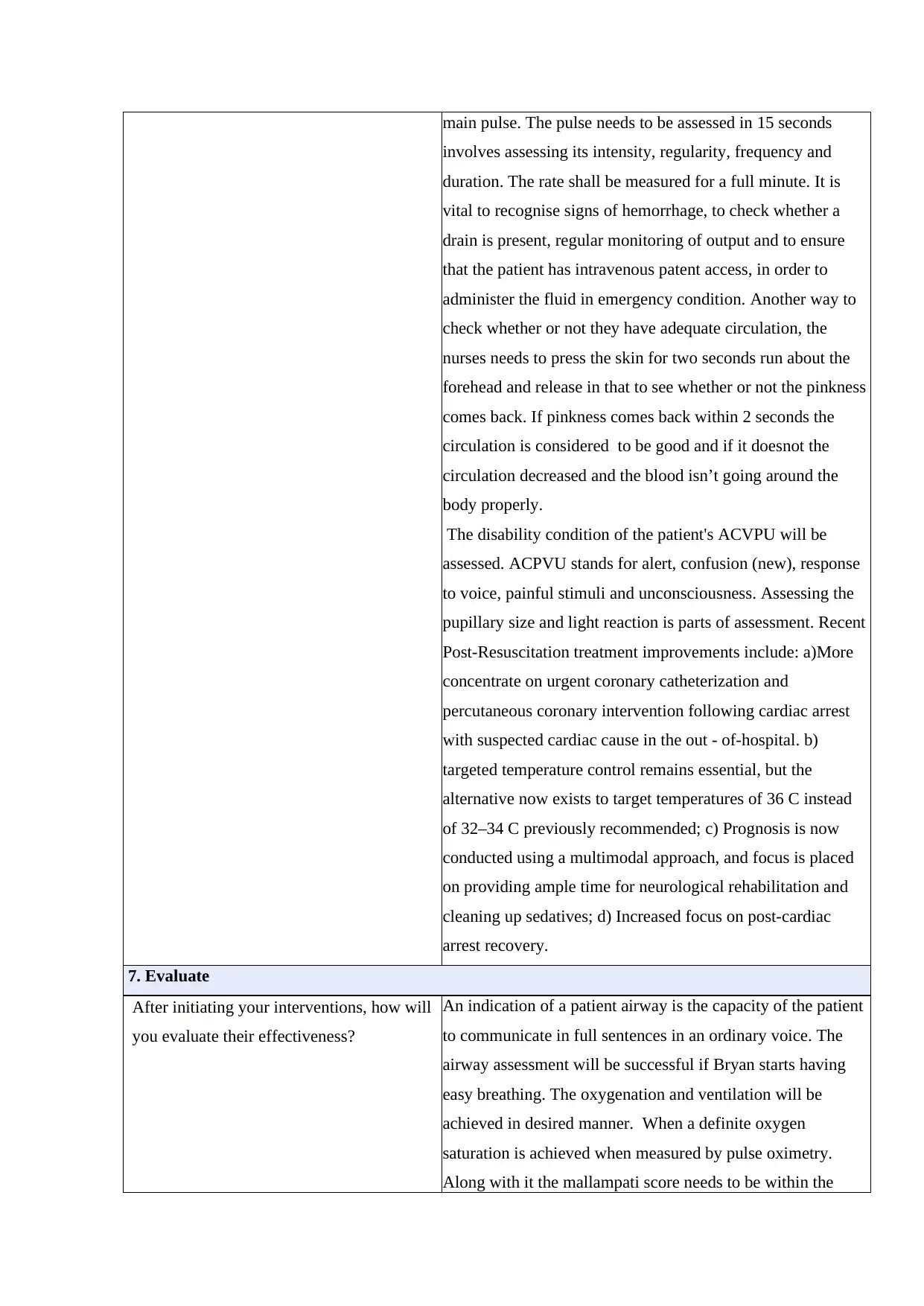
main pulse. The pulse needs to be assessed in 15 seconds
involves assessing its intensity, regularity, frequency and
duration. The rate shall be measured for a full minute. It is
vital to recognise signs of hemorrhage, to check whether a
drain is present, regular monitoring of output and to ensure
that the patient has intravenous patent access, in order to
administer the fluid in emergency condition. Another way to
check whether or not they have adequate circulation, the
nurses needs to press the skin for two seconds run about the
forehead and release in that to see whether or not the pinkness
comes back. If pinkness comes back within 2 seconds the
circulation is considered to be good and if it doesnot the
circulation decreased and the blood isn’t going around the
body properly.
The disability condition of the patient's ACVPU will be
assessed. ACPVU stands for alert, confusion (new), response
to voice, painful stimuli and unconsciousness. Assessing the
pupillary size and light reaction is parts of assessment. Recent
Post-Resuscitation treatment improvements include: a)More
concentrate on urgent coronary catheterization and
percutaneous coronary intervention following cardiac arrest
with suspected cardiac cause in the out - of-hospital. b)
targeted temperature control remains essential, but the
alternative now exists to target temperatures of 36 C instead
of 32–34 C previously recommended; c) Prognosis is now
conducted using a multimodal approach, and focus is placed
on providing ample time for neurological rehabilitation and
cleaning up sedatives; d) Increased focus on post-cardiac
arrest recovery.
7. Evaluate
After initiating your interventions, how will
you evaluate their effectiveness?
An indication of a patient airway is the capacity of the patient
to communicate in full sentences in an ordinary voice. The
airway assessment will be successful if Bryan starts having
easy breathing. The oxygenation and ventilation will be
achieved in desired manner. When a definite oxygen
saturation is achieved when measured by pulse oximetry.
Along with it the mallampati score needs to be within the
involves assessing its intensity, regularity, frequency and
duration. The rate shall be measured for a full minute. It is
vital to recognise signs of hemorrhage, to check whether a
drain is present, regular monitoring of output and to ensure
that the patient has intravenous patent access, in order to
administer the fluid in emergency condition. Another way to
check whether or not they have adequate circulation, the
nurses needs to press the skin for two seconds run about the
forehead and release in that to see whether or not the pinkness
comes back. If pinkness comes back within 2 seconds the
circulation is considered to be good and if it doesnot the
circulation decreased and the blood isn’t going around the
body properly.
The disability condition of the patient's ACVPU will be
assessed. ACPVU stands for alert, confusion (new), response
to voice, painful stimuli and unconsciousness. Assessing the
pupillary size and light reaction is parts of assessment. Recent
Post-Resuscitation treatment improvements include: a)More
concentrate on urgent coronary catheterization and
percutaneous coronary intervention following cardiac arrest
with suspected cardiac cause in the out - of-hospital. b)
targeted temperature control remains essential, but the
alternative now exists to target temperatures of 36 C instead
of 32–34 C previously recommended; c) Prognosis is now
conducted using a multimodal approach, and focus is placed
on providing ample time for neurological rehabilitation and
cleaning up sedatives; d) Increased focus on post-cardiac
arrest recovery.
7. Evaluate
After initiating your interventions, how will
you evaluate their effectiveness?
An indication of a patient airway is the capacity of the patient
to communicate in full sentences in an ordinary voice. The
airway assessment will be successful if Bryan starts having
easy breathing. The oxygenation and ventilation will be
achieved in desired manner. When a definite oxygen
saturation is achieved when measured by pulse oximetry.
Along with it the mallampati score needs to be within the
Paraphrase This Document
Need a fresh take? Get an instant paraphrase of this document with our AI Paraphraser
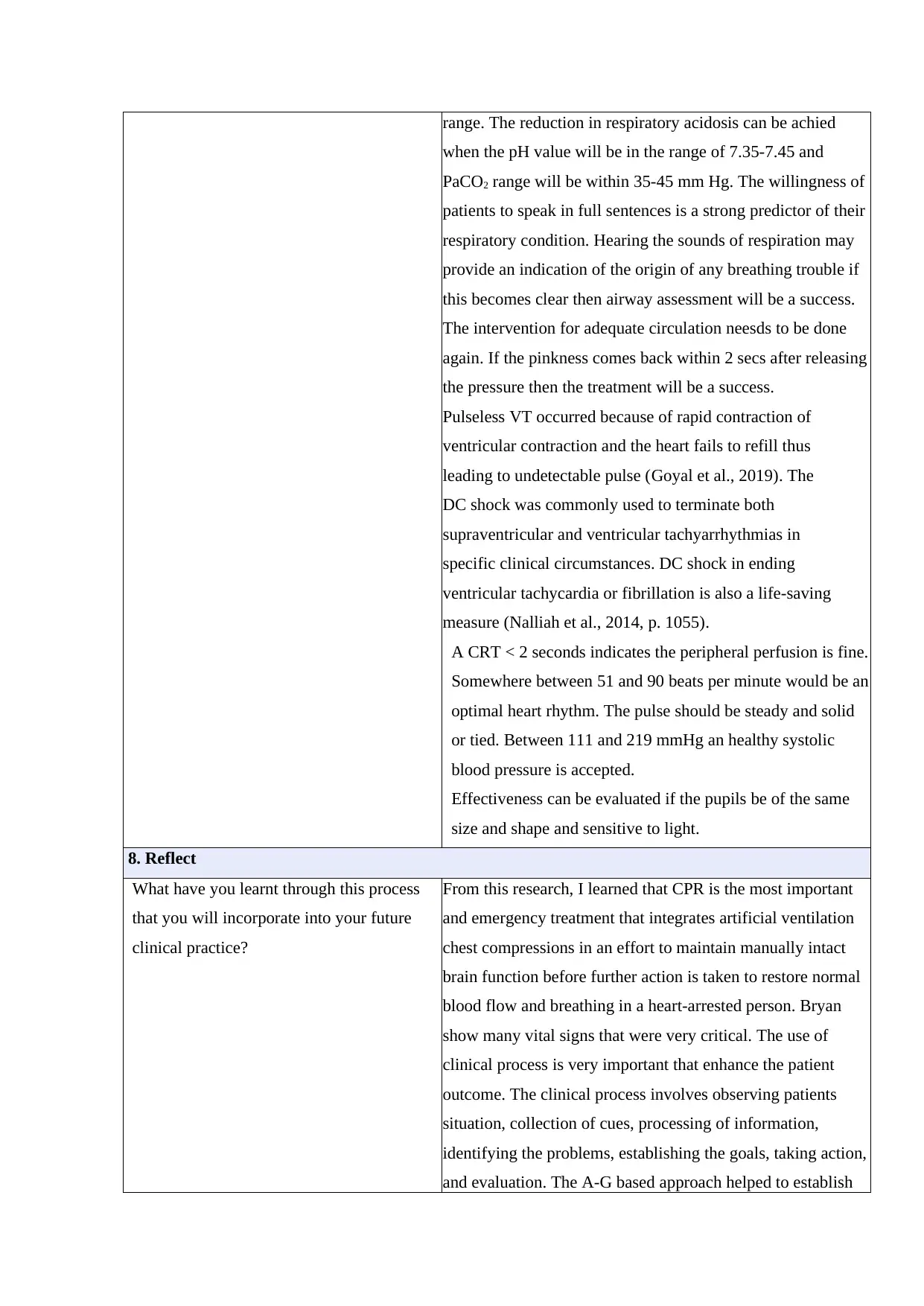
range. The reduction in respiratory acidosis can be achied
when the pH value will be in the range of 7.35-7.45 and
PaCO2 range will be within 35-45 mm Hg. The willingness of
patients to speak in full sentences is a strong predictor of their
respiratory condition. Hearing the sounds of respiration may
provide an indication of the origin of any breathing trouble if
this becomes clear then airway assessment will be a success.
The intervention for adequate circulation neesds to be done
again. If the pinkness comes back within 2 secs after releasing
the pressure then the treatment will be a success.
Pulseless VT occurred because of rapid contraction of
ventricular contraction and the heart fails to refill thus
leading to undetectable pulse (Goyal et al., 2019). The
DC shock was commonly used to terminate both
supraventricular and ventricular tachyarrhythmias in
specific clinical circumstances. DC shock in ending
ventricular tachycardia or fibrillation is also a life-saving
measure (Nalliah et al., 2014, p. 1055).
A CRT < 2 seconds indicates the peripheral perfusion is fine.
Somewhere between 51 and 90 beats per minute would be an
optimal heart rhythm. The pulse should be steady and solid
or tied. Between 111 and 219 mmHg an healthy systolic
blood pressure is accepted.
Effectiveness can be evaluated if the pupils be of the same
size and shape and sensitive to light.
8. Reflect
What have you learnt through this process
that you will incorporate into your future
clinical practice?
From this research, I learned that CPR is the most important
and emergency treatment that integrates artificial ventilation
chest compressions in an effort to maintain manually intact
brain function before further action is taken to restore normal
blood flow and breathing in a heart-arrested person. Bryan
show many vital signs that were very critical. The use of
clinical process is very important that enhance the patient
outcome. The clinical process involves observing patients
situation, collection of cues, processing of information,
identifying the problems, establishing the goals, taking action,
and evaluation. The A-G based approach helped to establish
when the pH value will be in the range of 7.35-7.45 and
PaCO2 range will be within 35-45 mm Hg. The willingness of
patients to speak in full sentences is a strong predictor of their
respiratory condition. Hearing the sounds of respiration may
provide an indication of the origin of any breathing trouble if
this becomes clear then airway assessment will be a success.
The intervention for adequate circulation neesds to be done
again. If the pinkness comes back within 2 secs after releasing
the pressure then the treatment will be a success.
Pulseless VT occurred because of rapid contraction of
ventricular contraction and the heart fails to refill thus
leading to undetectable pulse (Goyal et al., 2019). The
DC shock was commonly used to terminate both
supraventricular and ventricular tachyarrhythmias in
specific clinical circumstances. DC shock in ending
ventricular tachycardia or fibrillation is also a life-saving
measure (Nalliah et al., 2014, p. 1055).
A CRT < 2 seconds indicates the peripheral perfusion is fine.
Somewhere between 51 and 90 beats per minute would be an
optimal heart rhythm. The pulse should be steady and solid
or tied. Between 111 and 219 mmHg an healthy systolic
blood pressure is accepted.
Effectiveness can be evaluated if the pupils be of the same
size and shape and sensitive to light.
8. Reflect
What have you learnt through this process
that you will incorporate into your future
clinical practice?
From this research, I learned that CPR is the most important
and emergency treatment that integrates artificial ventilation
chest compressions in an effort to maintain manually intact
brain function before further action is taken to restore normal
blood flow and breathing in a heart-arrested person. Bryan
show many vital signs that were very critical. The use of
clinical process is very important that enhance the patient
outcome. The clinical process involves observing patients
situation, collection of cues, processing of information,
identifying the problems, establishing the goals, taking action,
and evaluation. The A-G based approach helped to establish
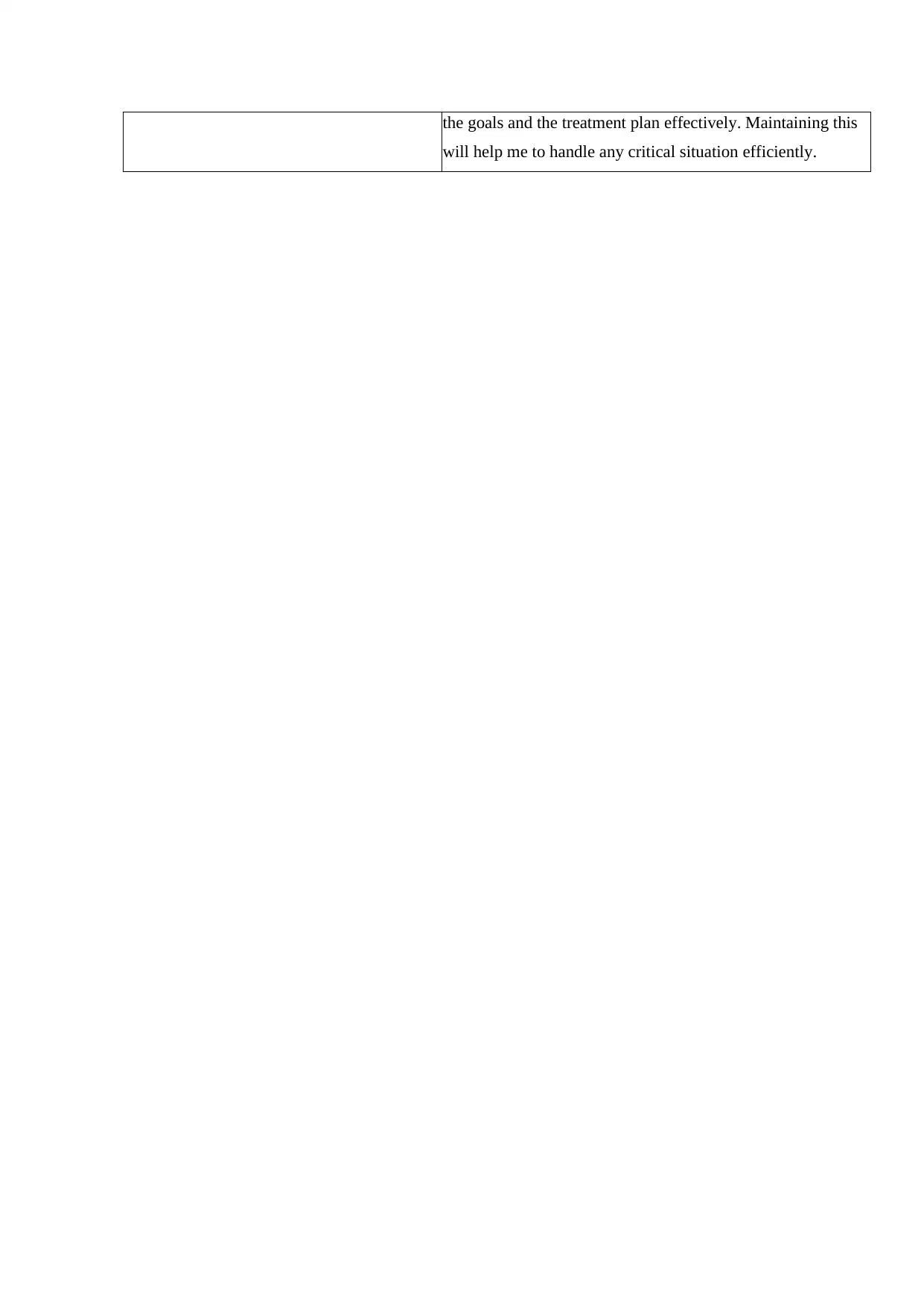
the goals and the treatment plan effectively. Maintaining this
will help me to handle any critical situation efficiently.
will help me to handle any critical situation efficiently.
⊘ This is a preview!⊘
Do you want full access?
Subscribe today to unlock all pages.

Trusted by 1+ million students worldwide
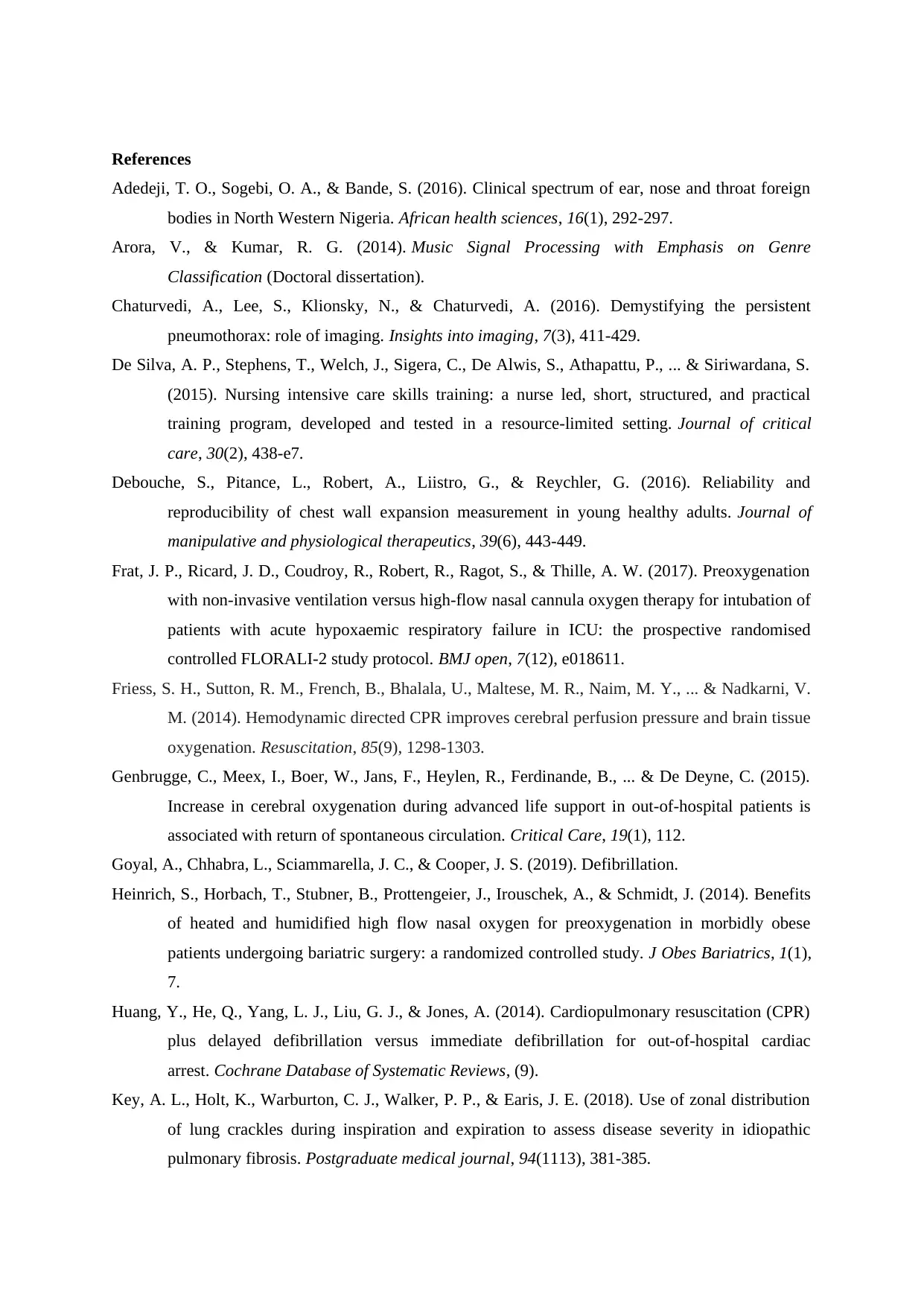
References
Adedeji, T. O., Sogebi, O. A., & Bande, S. (2016). Clinical spectrum of ear, nose and throat foreign
bodies in North Western Nigeria. African health sciences, 16(1), 292-297.
Arora, V., & Kumar, R. G. (2014). Music Signal Processing with Emphasis on Genre
Classification (Doctoral dissertation).
Chaturvedi, A., Lee, S., Klionsky, N., & Chaturvedi, A. (2016). Demystifying the persistent
pneumothorax: role of imaging. Insights into imaging, 7(3), 411-429.
De Silva, A. P., Stephens, T., Welch, J., Sigera, C., De Alwis, S., Athapattu, P., ... & Siriwardana, S.
(2015). Nursing intensive care skills training: a nurse led, short, structured, and practical
training program, developed and tested in a resource-limited setting. Journal of critical
care, 30(2), 438-e7.
Debouche, S., Pitance, L., Robert, A., Liistro, G., & Reychler, G. (2016). Reliability and
reproducibility of chest wall expansion measurement in young healthy adults. Journal of
manipulative and physiological therapeutics, 39(6), 443-449.
Frat, J. P., Ricard, J. D., Coudroy, R., Robert, R., Ragot, S., & Thille, A. W. (2017). Preoxygenation
with non-invasive ventilation versus high-flow nasal cannula oxygen therapy for intubation of
patients with acute hypoxaemic respiratory failure in ICU: the prospective randomised
controlled FLORALI-2 study protocol. BMJ open, 7(12), e018611.
Friess, S. H., Sutton, R. M., French, B., Bhalala, U., Maltese, M. R., Naim, M. Y., ... & Nadkarni, V.
M. (2014). Hemodynamic directed CPR improves cerebral perfusion pressure and brain tissue
oxygenation. Resuscitation, 85(9), 1298-1303.
Genbrugge, C., Meex, I., Boer, W., Jans, F., Heylen, R., Ferdinande, B., ... & De Deyne, C. (2015).
Increase in cerebral oxygenation during advanced life support in out-of-hospital patients is
associated with return of spontaneous circulation. Critical Care, 19(1), 112.
Goyal, A., Chhabra, L., Sciammarella, J. C., & Cooper, J. S. (2019). Defibrillation.
Heinrich, S., Horbach, T., Stubner, B., Prottengeier, J., Irouschek, A., & Schmidt, J. (2014). Benefits
of heated and humidified high flow nasal oxygen for preoxygenation in morbidly obese
patients undergoing bariatric surgery: a randomized controlled study. J Obes Bariatrics, 1(1),
7.
Huang, Y., He, Q., Yang, L. J., Liu, G. J., & Jones, A. (2014). Cardiopulmonary resuscitation (CPR)
plus delayed defibrillation versus immediate defibrillation for out‐of‐hospital cardiac
arrest. Cochrane Database of Systematic Reviews, (9).
Key, A. L., Holt, K., Warburton, C. J., Walker, P. P., & Earis, J. E. (2018). Use of zonal distribution
of lung crackles during inspiration and expiration to assess disease severity in idiopathic
pulmonary fibrosis. Postgraduate medical journal, 94(1113), 381-385.
Adedeji, T. O., Sogebi, O. A., & Bande, S. (2016). Clinical spectrum of ear, nose and throat foreign
bodies in North Western Nigeria. African health sciences, 16(1), 292-297.
Arora, V., & Kumar, R. G. (2014). Music Signal Processing with Emphasis on Genre
Classification (Doctoral dissertation).
Chaturvedi, A., Lee, S., Klionsky, N., & Chaturvedi, A. (2016). Demystifying the persistent
pneumothorax: role of imaging. Insights into imaging, 7(3), 411-429.
De Silva, A. P., Stephens, T., Welch, J., Sigera, C., De Alwis, S., Athapattu, P., ... & Siriwardana, S.
(2015). Nursing intensive care skills training: a nurse led, short, structured, and practical
training program, developed and tested in a resource-limited setting. Journal of critical
care, 30(2), 438-e7.
Debouche, S., Pitance, L., Robert, A., Liistro, G., & Reychler, G. (2016). Reliability and
reproducibility of chest wall expansion measurement in young healthy adults. Journal of
manipulative and physiological therapeutics, 39(6), 443-449.
Frat, J. P., Ricard, J. D., Coudroy, R., Robert, R., Ragot, S., & Thille, A. W. (2017). Preoxygenation
with non-invasive ventilation versus high-flow nasal cannula oxygen therapy for intubation of
patients with acute hypoxaemic respiratory failure in ICU: the prospective randomised
controlled FLORALI-2 study protocol. BMJ open, 7(12), e018611.
Friess, S. H., Sutton, R. M., French, B., Bhalala, U., Maltese, M. R., Naim, M. Y., ... & Nadkarni, V.
M. (2014). Hemodynamic directed CPR improves cerebral perfusion pressure and brain tissue
oxygenation. Resuscitation, 85(9), 1298-1303.
Genbrugge, C., Meex, I., Boer, W., Jans, F., Heylen, R., Ferdinande, B., ... & De Deyne, C. (2015).
Increase in cerebral oxygenation during advanced life support in out-of-hospital patients is
associated with return of spontaneous circulation. Critical Care, 19(1), 112.
Goyal, A., Chhabra, L., Sciammarella, J. C., & Cooper, J. S. (2019). Defibrillation.
Heinrich, S., Horbach, T., Stubner, B., Prottengeier, J., Irouschek, A., & Schmidt, J. (2014). Benefits
of heated and humidified high flow nasal oxygen for preoxygenation in morbidly obese
patients undergoing bariatric surgery: a randomized controlled study. J Obes Bariatrics, 1(1),
7.
Huang, Y., He, Q., Yang, L. J., Liu, G. J., & Jones, A. (2014). Cardiopulmonary resuscitation (CPR)
plus delayed defibrillation versus immediate defibrillation for out‐of‐hospital cardiac
arrest. Cochrane Database of Systematic Reviews, (9).
Key, A. L., Holt, K., Warburton, C. J., Walker, P. P., & Earis, J. E. (2018). Use of zonal distribution
of lung crackles during inspiration and expiration to assess disease severity in idiopathic
pulmonary fibrosis. Postgraduate medical journal, 94(1113), 381-385.
Paraphrase This Document
Need a fresh take? Get an instant paraphrase of this document with our AI Paraphraser
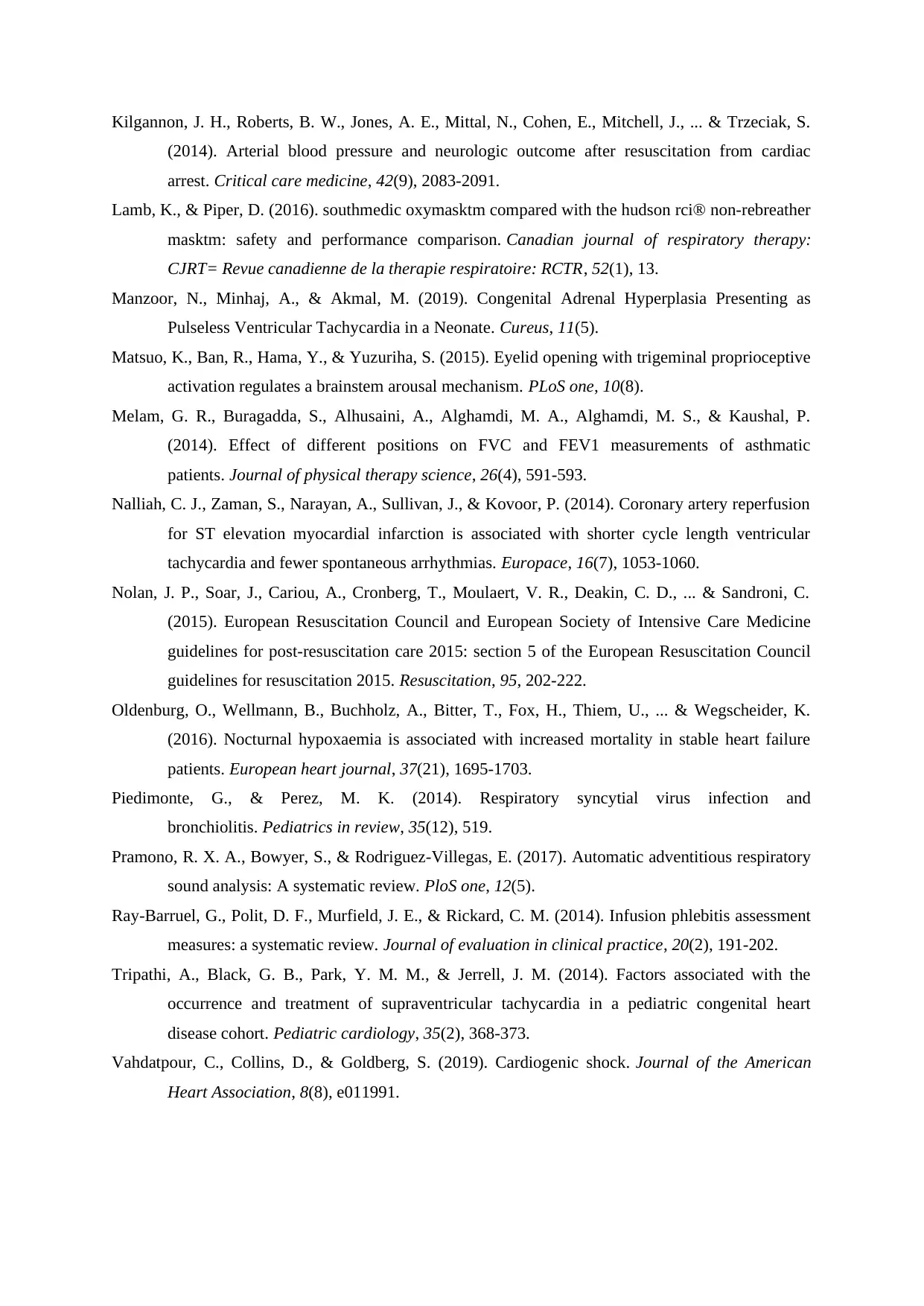
Kilgannon, J. H., Roberts, B. W., Jones, A. E., Mittal, N., Cohen, E., Mitchell, J., ... & Trzeciak, S.
(2014). Arterial blood pressure and neurologic outcome after resuscitation from cardiac
arrest. Critical care medicine, 42(9), 2083-2091.
Lamb, K., & Piper, D. (2016). southmedic oxymasktm compared with the hudson rci® non-rebreather
masktm: safety and performance comparison. Canadian journal of respiratory therapy:
CJRT= Revue canadienne de la therapie respiratoire: RCTR, 52(1), 13.
Manzoor, N., Minhaj, A., & Akmal, M. (2019). Congenital Adrenal Hyperplasia Presenting as
Pulseless Ventricular Tachycardia in a Neonate. Cureus, 11(5).
Matsuo, K., Ban, R., Hama, Y., & Yuzuriha, S. (2015). Eyelid opening with trigeminal proprioceptive
activation regulates a brainstem arousal mechanism. PLoS one, 10(8).
Melam, G. R., Buragadda, S., Alhusaini, A., Alghamdi, M. A., Alghamdi, M. S., & Kaushal, P.
(2014). Effect of different positions on FVC and FEV1 measurements of asthmatic
patients. Journal of physical therapy science, 26(4), 591-593.
Nalliah, C. J., Zaman, S., Narayan, A., Sullivan, J., & Kovoor, P. (2014). Coronary artery reperfusion
for ST elevation myocardial infarction is associated with shorter cycle length ventricular
tachycardia and fewer spontaneous arrhythmias. Europace, 16(7), 1053-1060.
Nolan, J. P., Soar, J., Cariou, A., Cronberg, T., Moulaert, V. R., Deakin, C. D., ... & Sandroni, C.
(2015). European Resuscitation Council and European Society of Intensive Care Medicine
guidelines for post-resuscitation care 2015: section 5 of the European Resuscitation Council
guidelines for resuscitation 2015. Resuscitation, 95, 202-222.
Oldenburg, O., Wellmann, B., Buchholz, A., Bitter, T., Fox, H., Thiem, U., ... & Wegscheider, K.
(2016). Nocturnal hypoxaemia is associated with increased mortality in stable heart failure
patients. European heart journal, 37(21), 1695-1703.
Piedimonte, G., & Perez, M. K. (2014). Respiratory syncytial virus infection and
bronchiolitis. Pediatrics in review, 35(12), 519.
Pramono, R. X. A., Bowyer, S., & Rodriguez-Villegas, E. (2017). Automatic adventitious respiratory
sound analysis: A systematic review. PloS one, 12(5).
Ray‐Barruel, G., Polit, D. F., Murfield, J. E., & Rickard, C. M. (2014). Infusion phlebitis assessment
measures: a systematic review. Journal of evaluation in clinical practice, 20(2), 191-202.
Tripathi, A., Black, G. B., Park, Y. M. M., & Jerrell, J. M. (2014). Factors associated with the
occurrence and treatment of supraventricular tachycardia in a pediatric congenital heart
disease cohort. Pediatric cardiology, 35(2), 368-373.
Vahdatpour, C., Collins, D., & Goldberg, S. (2019). Cardiogenic shock. Journal of the American
Heart Association, 8(8), e011991.
(2014). Arterial blood pressure and neurologic outcome after resuscitation from cardiac
arrest. Critical care medicine, 42(9), 2083-2091.
Lamb, K., & Piper, D. (2016). southmedic oxymasktm compared with the hudson rci® non-rebreather
masktm: safety and performance comparison. Canadian journal of respiratory therapy:
CJRT= Revue canadienne de la therapie respiratoire: RCTR, 52(1), 13.
Manzoor, N., Minhaj, A., & Akmal, M. (2019). Congenital Adrenal Hyperplasia Presenting as
Pulseless Ventricular Tachycardia in a Neonate. Cureus, 11(5).
Matsuo, K., Ban, R., Hama, Y., & Yuzuriha, S. (2015). Eyelid opening with trigeminal proprioceptive
activation regulates a brainstem arousal mechanism. PLoS one, 10(8).
Melam, G. R., Buragadda, S., Alhusaini, A., Alghamdi, M. A., Alghamdi, M. S., & Kaushal, P.
(2014). Effect of different positions on FVC and FEV1 measurements of asthmatic
patients. Journal of physical therapy science, 26(4), 591-593.
Nalliah, C. J., Zaman, S., Narayan, A., Sullivan, J., & Kovoor, P. (2014). Coronary artery reperfusion
for ST elevation myocardial infarction is associated with shorter cycle length ventricular
tachycardia and fewer spontaneous arrhythmias. Europace, 16(7), 1053-1060.
Nolan, J. P., Soar, J., Cariou, A., Cronberg, T., Moulaert, V. R., Deakin, C. D., ... & Sandroni, C.
(2015). European Resuscitation Council and European Society of Intensive Care Medicine
guidelines for post-resuscitation care 2015: section 5 of the European Resuscitation Council
guidelines for resuscitation 2015. Resuscitation, 95, 202-222.
Oldenburg, O., Wellmann, B., Buchholz, A., Bitter, T., Fox, H., Thiem, U., ... & Wegscheider, K.
(2016). Nocturnal hypoxaemia is associated with increased mortality in stable heart failure
patients. European heart journal, 37(21), 1695-1703.
Piedimonte, G., & Perez, M. K. (2014). Respiratory syncytial virus infection and
bronchiolitis. Pediatrics in review, 35(12), 519.
Pramono, R. X. A., Bowyer, S., & Rodriguez-Villegas, E. (2017). Automatic adventitious respiratory
sound analysis: A systematic review. PloS one, 12(5).
Ray‐Barruel, G., Polit, D. F., Murfield, J. E., & Rickard, C. M. (2014). Infusion phlebitis assessment
measures: a systematic review. Journal of evaluation in clinical practice, 20(2), 191-202.
Tripathi, A., Black, G. B., Park, Y. M. M., & Jerrell, J. M. (2014). Factors associated with the
occurrence and treatment of supraventricular tachycardia in a pediatric congenital heart
disease cohort. Pediatric cardiology, 35(2), 368-373.
Vahdatpour, C., Collins, D., & Goldberg, S. (2019). Cardiogenic shock. Journal of the American
Heart Association, 8(8), e011991.
1 out of 11
Related Documents
Your All-in-One AI-Powered Toolkit for Academic Success.
+13062052269
info@desklib.com
Available 24*7 on WhatsApp / Email
![[object Object]](/_next/static/media/star-bottom.7253800d.svg)
Unlock your academic potential
Copyright © 2020–2025 A2Z Services. All Rights Reserved. Developed and managed by ZUCOL.





